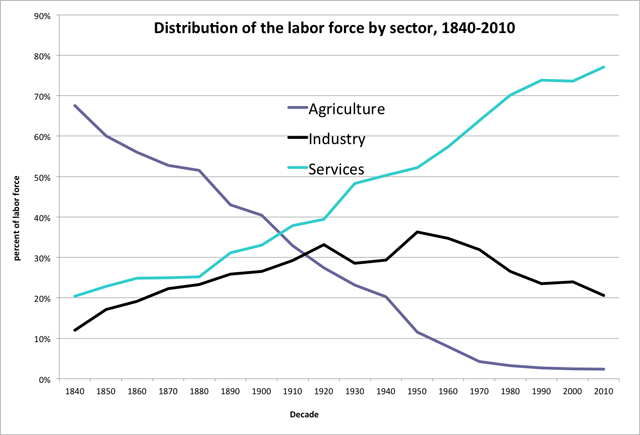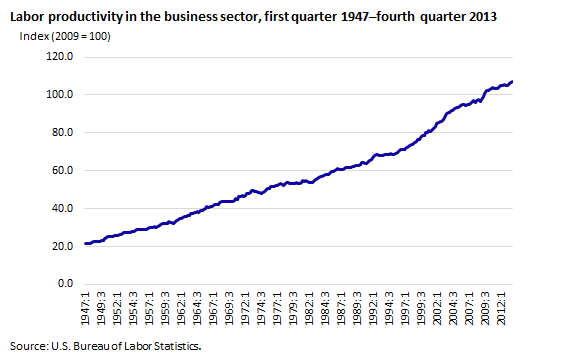Our society is coming to the conclusion that the current economic system does not function satisfactorily. Inequality is reaching intolerable levels. From many different directions (Piketty, Trump, Warren, AOC, etc) people are demanding fundamental changes in the economic structure of society. There’s little agreement on the precise nature of the preferred change, but we all know that there must be big changes to our economic system.
A Little History
Let’s get back to basics. Hunter-gatherer societies tens of thousands of years ago had no economies to speak of; it wasn’t until the agricultural revolution that we saw economic interactions among strangers. These command economies were almost entirely agricultural. Perhaps 90% of all labor was on the farm. The other 10% was divided among various service groups: priests, soldiers, and administrators (lords). There was also a tiny group of manufacturing laborers making tools, boats, houses, clothes, weapons, and ornaments for the lords.
As societies grew larger and wealthier, the fraction of workers required to grow the food slowly declined; more of the population was diverted to other tasks, such as the army, the administration (they needed bean-counters back then, too), and of course, manufacturing. In general, it’s most illuminating to see this process as a diversion of labor from agriculture to manufacturing.
The first shock: the Industrial Revolution
The process continued steadily, with minor ups and downs for little fluctuations like the fall of Rome or the Black Death, right up into about 1800 CE. By that time, the agricultural labor force had declined considerably, and agricultural laborers were recruited for manufacturing tasks at home. Most clothing was made under a combination of “put-out” systems in which a businessman organized groups of farmers to provide wool, process the wool, spin it into thread, and weave it into cloth, all done at home. The dream of working at home is really just a reversion to earlier production models.
Then came the Industrial Revolution. Although the steam engine was literally the driving force behind the Industrial Revolution, it was the invention of machines for spinning and weaving that made the biggest changes. The farmers and their wives who made ends meet by spinning and weaving found themselves out of work. Yes, their jobs were lost to automation. This provoked a wave of “terrorist attacks” or “economic justice actions”, depending on your point of view, in which people destroyed the machines that had been throwing them out of work. The tale is that one Ned Ludd started it all by smashing one of the machines in a fit of anger; thereafter, all such attacks were attributed to “Luddites”. There never was any organized effort to shut down the factories; it was really just a series of random mob attacks. But the British establishment perceived the Luddites the way that Trumpsters perceive immigrants.
All through the nineteenth century, society struggled with the effects of industrialization. Eventually the labor force was integrated into the new factory system, but their lot was brutal and there was much fearful anticipation of what might happen should they ever manifest their anger at the unfairness of the system in a coordinated manner. It wasn’t until the mid-twentieth century that advanced societies worked out the kinks in the industrial system and provided manufacturing jobs that were good enough to keep the labor force from storming the Bastille.
Meanwhile…
Less noticeable was the fundamental change in society wrought by all that manufacturing. All these factories were manufacturing lots of consumer goods at steadily decreasing prices. People were able to afford a change of clothes! And then they could afford to have different clothes for summer and winter! And then special clothes for dress-up occasions like Sunday church! The price of everything tumbled. In the early 19th century, books were so rare that Abraham Lincoln would walk miles just to borrow a book from somebody, and he memorized many of the books he read. By the beginning of the 20th century, many households had a few dozen books. Shoes, hats, newspapers, kerosene lamps, and all manner of other consumer goods flooded the market. In the 20th century, we got cars, then washing machines, air conditioners, radios, televisions — the explosion of consumer goods just kept exploding ever more explosively.
While all this was happening, agricultural employment plummeted. Today, less than 2% of the population is employed in agriculture in the USA. Here’s the history of how labor has been employed in the US economy for the last 170 years:

Source: 1840–1900: Robert E. Gallman and Thomas J. Weiss. “The Service Industries in the Nineteenth Century.” In Production and Productivity in the Service Industries, ed. Victor R. Fuchs, 287–352. New York: Columbia University Press (for NBER), 1969.
The decline of agricultural employment was not a source of social stress because industry rapidly soaked up all the unemployed.
Then they came for the manufacturing workers
But the graph above shows that manufacturing jobs peaked over 50 years ago and have been slowly declining ever since. That’s largely due to automation, not offshoring. Take a gander at this graph of labor productivity over the last 65 years:

Gee, US workers are more than five times more productive today than just 65 years ago. Do you think that’s because US workers are five times smarter, five times stronger, or five times faster than their 1947 predecessors? I don’t think so. It’s entirely because they’re using more equipment — more capital — than they were employing back then. All that extra productivity is coming from the capital, not the labor. So is it any surprise that most of the benefits from that capital end up going to the people who own the capital (the capitalist pigs) rather than the workers? Yes, wages have gone up even though workers aren’t any faster, stronger, or smarter, but wages have not kept up with economic growth. The excess wealth is going to the wealthy.
Drowning in consumer goods
One consequence of all this increased productivity is a deadly surplus of everything. Throughout most of history, malnutrition and outright starvation were the predominant killers of billions of people. But nowadays in America, it’s the surplus of food that’s more dangerous than a shortage: people are dying from eating too much fatty foods, too much sugar, too much of everything.
The same thing goes for consumer goods of all kinds. Most American families have several cars; some even provide cars to their teenage kids. Almost everybody has a smartphone and many have computers. People have huge stocks of clothes, shoes, toys, doodads, gizmos, and just plain junk. We have more stuff than we can keep at home; we spend $38 billion just on self-storage units, using up over 2 billion square feet of storage for our junk. That’s a lot of junk!
Just as we now have more food than we need, we now have more stuff than we can use. Our homes are stuffed with fancy tools that we seldom use, more clothes than we can wear, electronic devices that we don’t know how to utilize, and cars twice as big as we need. It’s been fun, but now my wife and I have reached the point where we end up buying something because we can’t find the one we already have: it’s buried underneath other junk.
A breaking point?
This is why people are so unhappy with the current system: it just isn’t providing a satisfactory return for their labor. They’ve got too much of what they don’t need, and they see the wealth going to other people.
It’s definitely time for a major shift in our economic structure. Some people think in terms of a revolution: “Power to the people!” Others talk about legislative packages to redress the huge inequality in our society. Others just talk vaguely about “draining the swamp”, meaning turning everything upside down. Mr. Trump has been doing that quite effectively for two years now, and look where that’s gotten us.
Services to the rescue
Economists point to services as the sector that will solve our problems. The first graph clearly shows that we’re already there: services already provide 75% of all the jobs in our economy, and they’re continuing to grow. It should be obvious that the future of our economy does not lie in manufacturing, but in services. All the talk about the US losing manufacturing jobs is no different from the complaints 200 years ago that machines were putting weavers and spinners out of business. Would you prefer that we go back to people spinning thread in their homes while watching TV at night?
The common criticism of this line of thinking is that we’ll all be reduced to flipping burgers. We’re replacing high-paying manufacturing jobs with low-paying menial jobs. They tell us that there won’t be many high-paying programmer jobs, and that the bulk of the workforce will slave away at stupid jobs. That’s bullshit. Two reasons why:
First, it underestimates the power of an even moderately educated workforce. A good example comes from World War II: America had a huge advantage over Germany and Japan because most Americans were already familiar with cars. Most Americans could drive; the German Army had to train its soldiers how to drive. When an American tank or truck broke down, half the guys standing around could help get it running again; the Japanese Army abandoned huge quantities of equipment because the few mechanics who could fix them couldn’t get there in time.
You don’t need a PhD to perform economically valuable services. You do need a high school diploma, and a bachelor’s degree would be even better. That’s why we need to make tertiary education a universal standard for all Americans. That means making it free. We don’t need to give everybody scholarships to Stanford and Harvard; we already have a community college system in place that can be readily expanded to cover a much larger population, and a similar expansion in the state colleges can do the same thing at the upper division level.
Educational services
Here’s where the next big jump happens: education. Our demographics are changing; more and more of our population consists of older Americans. We have a huge surplus of older people and a huge deficit of teachers. We should greatly expand our educational system to provide youngsters with far more individual attention than they now get. We have almost as many people over the age of 60 as we have under the age of 18. Why must we have a single class of employee called “teacher”? We break down all the other occupations into a wide range of specialties utilizing people with a wide range of skills and experience. Why can’t we do the same with education? Modern teachers carry out a huge range of tasks; we could break those tasks down into specialties that can be tackled by lots of different people.
Education is a service that is almost immune to automation. I’ve written educational software, and yes, educational software has its place, but direct human contact is by far the most important component of education, and we need millions of people to provide human contact to millions of kids. That’s how to expand the supply of jobs to replace the manufacturing jobs that are going away.
Conclusion
Ultimately, though, education is the best possible use of human talent. Nothing is as satisfying as directly helping another person. Nothing is as important as educating our future citizens. Which would you rather do: drive a forklift in a warehouse or help some kid with her homework?
Imagine a future society in which consumer goods are stamped out by armies of machines programmed and overseen by a small percentage of the population, while most people devote most of their time to helping those younger and less experienced than themselves. Does that society not seem to offer a more promising future for humanity?
